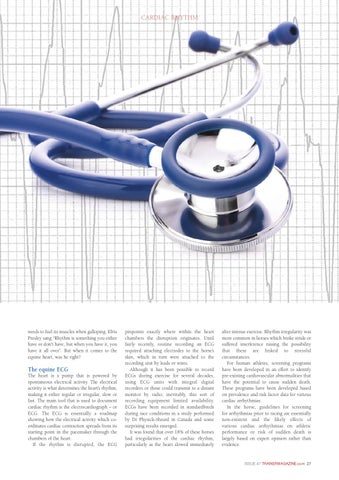CARDIAC RHYTHM
needs to fuel its muscles when galloping. Elvis Presley sang “Rhythm is something you either have or don't have, but when you have it, you have it all over”. But when it comes to the equine heart, was he right?
The equine ECG The heart is a pump that is powered by spontaneous electrical activity. The electrical activity is what determines the heart’s rhythm, making it either regular or irregular, slow or fast. The main tool that is used to document cardiac rhythm is the electrocardiograph – or ECG. The ECG is essentially a roadmap showing how the electrical activity which coordinates cardiac contraction spreads from its starting point in the pacemaker through the chambers of the heart. If the rhythm is disrupted, the ECG
pinpoints exactly where within the heart chambers the disruption originates. Until fairly recently, routine recording an ECG required attaching electrodes to the horse’s skin, which in turn were attached to the recording unit by leads or wires. Although it has been possible to record ECGs during exercise for several decades, using ECG units with integral digital recorders or those could transmit to a distant monitor by radio, inevitably, this sort of recording equipment limited availability. ECGs have been recorded in standardbreds during race conditions in a study performed by Dr Physick-Sheard in Canada and some surprising results emerged. It was found that over 18% of these horses had irregularities of the cardiac rhythm, particularly as the heart slowed immediately
after intense exercise. Rhythm irregularity was more common in horses which broke stride or suffered interference raising the possibility that these are linked to stressful circumstances. For human athletes, screening programs have been developed in an effort to identify pre-existing cardiovascular abnormalities that have the potential to cause sudden death. These programs have been developed based on prevalence and risk factor data for various cardiac arrhythmias. In the horse, guidelines for screening for arrhythmias prior to racing are essentially non-existent and the likely effects of various cardiac arrhythmias on athletic performance or risk of sudden death is largely based on expert opinion rather than evidence.
ISSUE 47 TRAINERMAGAZINE.com 27
